2005 BMW Z4 2.5I wheel
[x] Cancel search: wheelPage 80 of 120
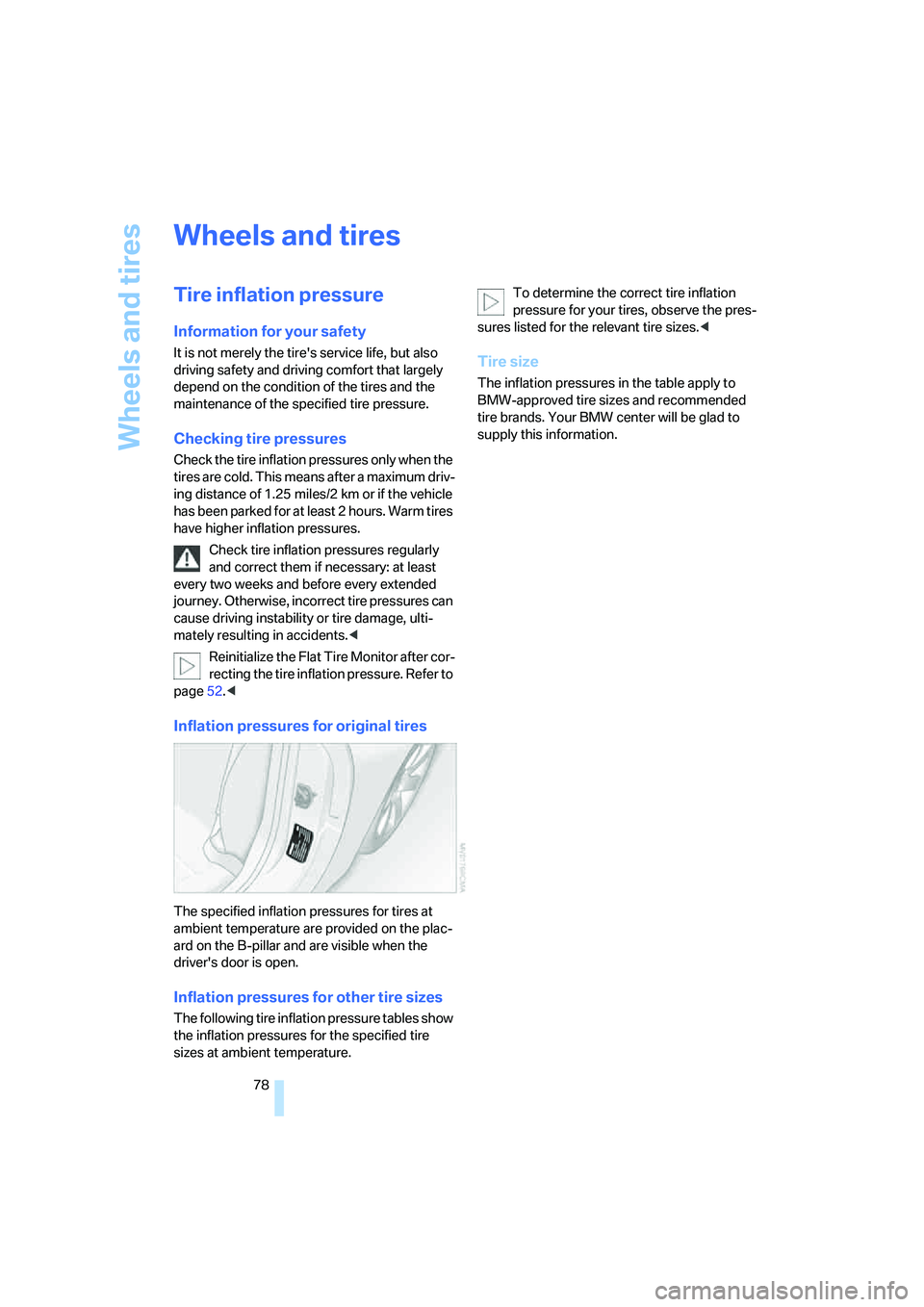
Wheels and tires
78
Wheels and tires
Tire inflation pressure
Information for your safety
It is not merely the tire's service life, but also
driving safety and driving comfort that largely
depend on the condition of the tires and the
maintenance of the specified tire pressure.
Checking tire pressures
Check the tire inflation pressures only when the
tires are cold. This means after a maximum driv-
ing distance of 1.25 miles/2 km or if the vehicle
has been parked for at least 2 hours. Warm tires
have higher inflation pressures.
Check tire inflation pressures regularly
and correct them if necessary: at least
every two weeks and before every extended
journey. Otherwise, incorrect tire pressures can
cause driving instability or tire damage, ulti-
mately resulting in accidents.<
Reinitialize the Flat Tire Monitor after cor-
recting the tire inflation pressure. Refer to
page52.<
Inflation pressures for original tires
The specified inflation pressures for tires at
ambient temperature are provided on the plac-
ard on the B-pillar and are visible when the
driver's door is open.
Inflation pressures for other tire sizes
The following tire inflation pressure tables show
the inflation pressures for the specified tire
sizes at ambient temperature.To determine the correct tire inflation
pressure for your tires, observe the pres-
sures listed for the relevant tire sizes.<
Tire size
The inflation pressures in the table apply to
BMW-approved tire sizes and recommended
tire brands. Your BMW center will be glad to
supply this information.
Page 82 of 120
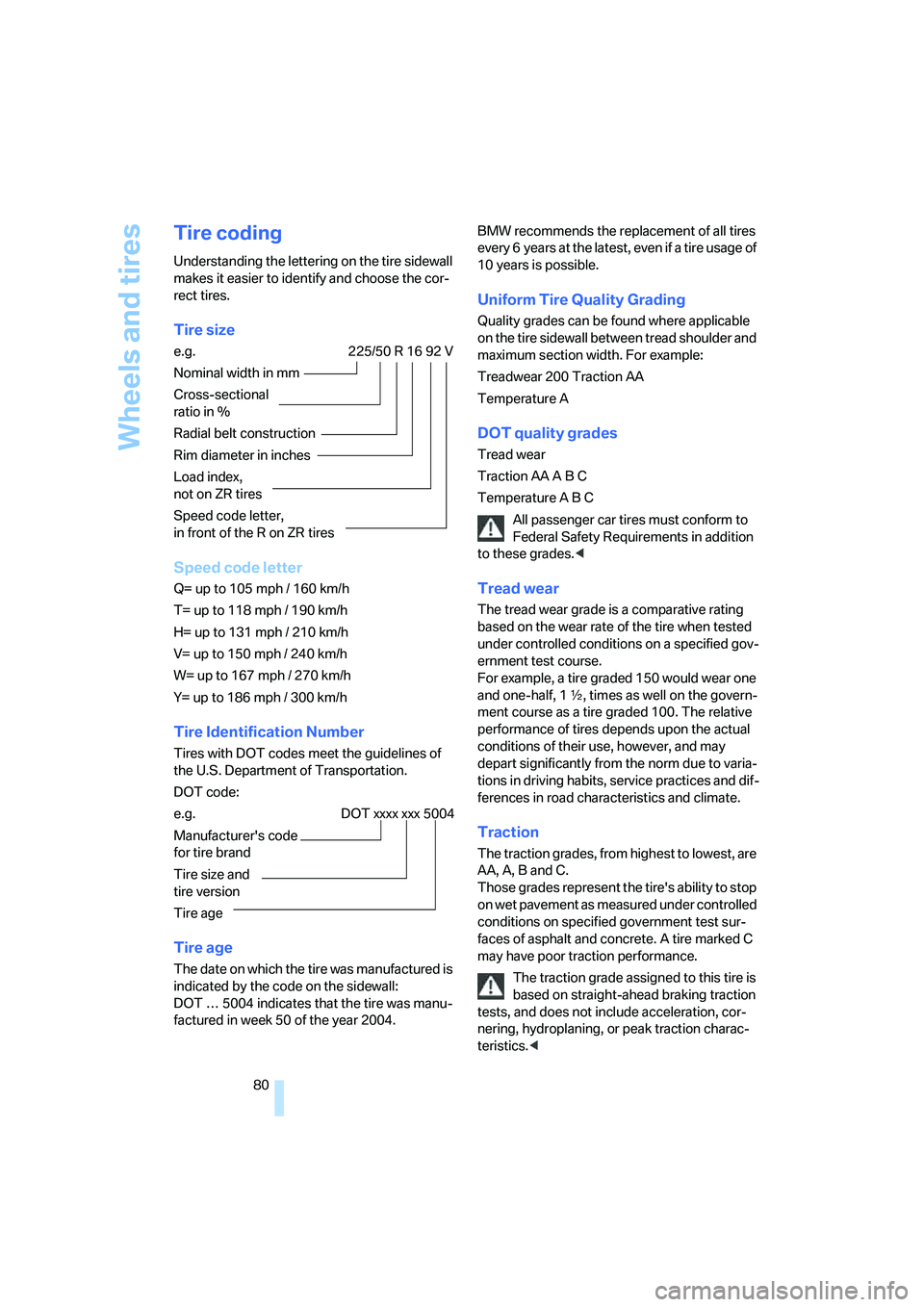
Wheels and tires
80
Tire coding
Understanding the lettering on the tire sidewall
makes it easier to identify and choose the cor-
rect tires.
Tire size
e.g. 225/50 R 16 92 V
Nominal width in mm
Cross-sectional
ratio in %
Radial belt construction
Rim diameter in inches
Load index,
not on ZR tires
Speed code letter,
in front of the R on ZR tires
Speed code letter
Q= up to 105 mph / 160 km/h
T= up to 118 mph / 190 km/h
H= up to 131 mph / 210 km/h
V= up to 150 mph / 240 km/h
W= up to 167 mph / 270 km/h
Y= up to 186 mph / 300 km/h
Tire Identification Number
Tires with DOT codes meet the guidelines of
the U.S. Department of Transportation.
DOT code:
e.g. DOT xxxx xxx 5004
Manufacturer's code
for tire brand
Tire size and
tire version
Tire age
Tire age
The date on which the tire was manufactured is
indicated by the code on the sidewall:
DOT … 5004 indicates that the tire was manu-
factured in week 50 of the year 2004.BMW recommends the replacement of all tires
every 6 years at the latest, even if a tire usage of
10 years is possible.
Uniform Tire Quality Grading
Quality grades can be found where applicable
on the tire sidewall between tread shoulder and
maximum section width. For example:
Treadwear 200 Traction AA
Temperature A
DOT quality grades
Tread wear
Traction AA A B C
Temperature A B C
All passenger car tires must conform to
Federal Safety Requirements in addition
to these grades.<
Tread wear
The tread wear grade is a comparative rating
based on the wear rate of the tire when tested
under controlled conditions on a specified gov-
ernment test course.
For example, a tire graded 150 would wear one
and one-half, 1 γ, times as well on the govern-
ment course as a tire graded 100. The relative
performance of tires depends upon the actual
conditions of their use, however, and may
depart significantly from the norm due to varia-
tions in driving habits, service practices and dif-
ferences in road characteristics and climate.
Traction
The traction grades, from highest to lowest, are
AA, A, B and C.
Those grades represent the tire's ability to stop
on wet pavement as measured under controlled
conditions on specified government test sur-
faces of asphalt and concrete. A tire marked C
may have poor traction performance.
The traction grade assigned to this tire is
based on straight-ahead braking traction
tests, and does not include acceleration, cor-
nering, hydroplaning, or peak traction charac-
teristics.<
Page 83 of 120
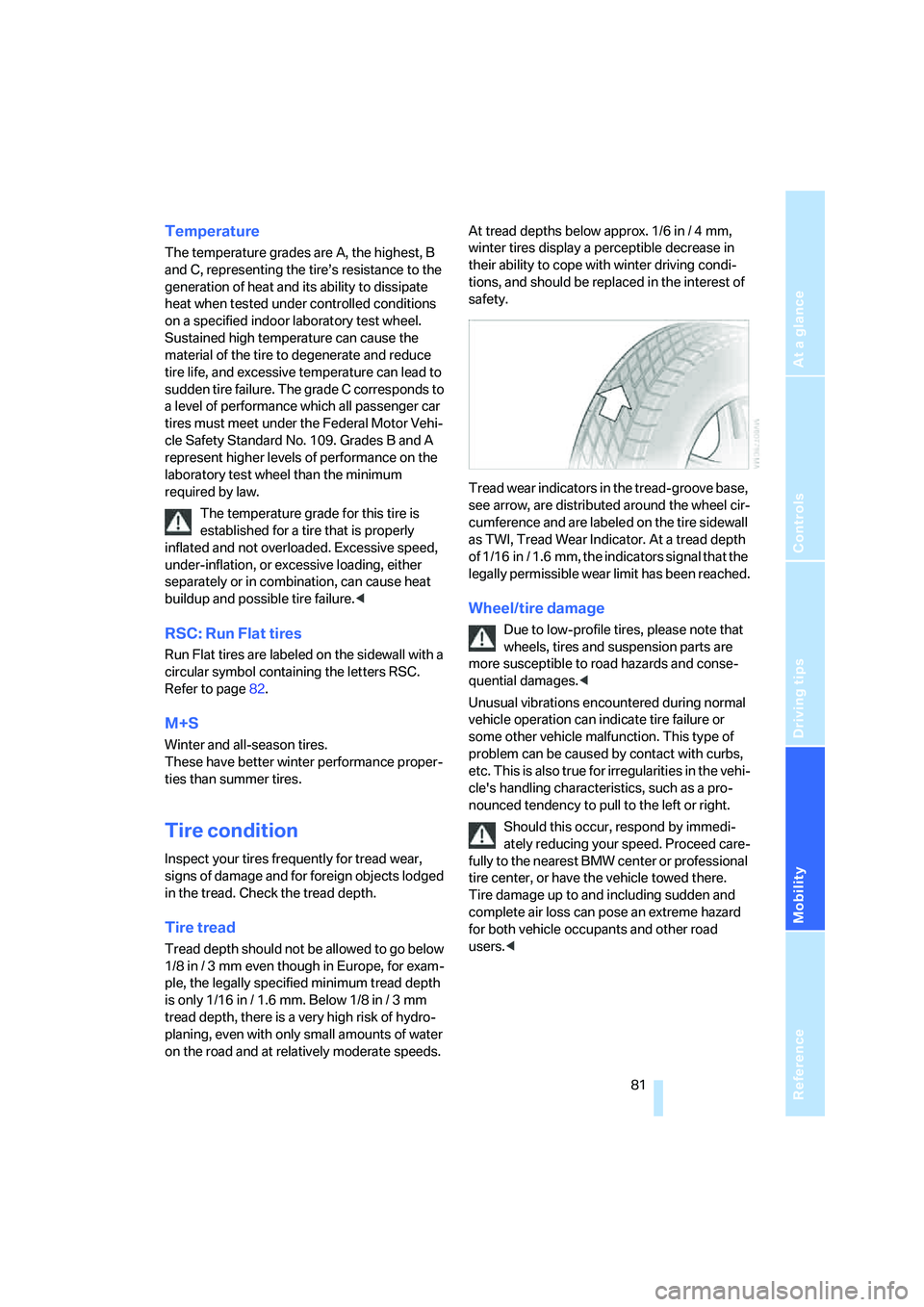
Reference
At a glance
Controls
Driving tips
Mobility
81
Temperature
The temperature grades are A, the highest, B
and C, representing the tire’s resistance to the
generation of heat and its ability to dissipate
heat when tested under controlled conditions
on a specified indoor laboratory test wheel.
Sustained high temperature can cause the
material of the tire to degenerate and reduce
tire life, and excessive temperature can lead to
sudden tire failure. The grade C corresponds to
a level of performance which all passenger car
tires must meet under the Federal Motor Vehi-
cle Safety Standard No. 109. Grades B and A
represent higher levels of performance on the
laboratory test wheel than the minimum
required by law.
The temperature grade for this tire is
established for a tire that is properly
inflated and not overloaded. Excessive speed,
under-inflation, or excessive loading, either
separately or in combination, can cause heat
buildup and possible tire failure.<
RSC: Run Flat tires
Run Flat tires are labeled on the sidewall with a
circular symbol containing the letters RSC.
Refer to page82.
M+S
Winter and all-season tires.
These have better winter performance proper-
ties than summer tires.
Tire condition
Inspect your tires frequently for tread wear,
signs of damage and for foreign objects lodged
in the tread. Check the tread depth.
Tire tread
Tread depth should not be allowed to go below
1/8 in / 3 mm even though in Europe, for exam-
ple, the legally specified minimum tread depth
is only 1/16 in / 1.6 mm. Below 1/8 in / 3 mm
tread depth, there is a very high risk of hydro-
planing, even with only small amounts of water
on the road and at relatively moderate speeds.At tread depths below approx. 1/6in/ 4mm,
winter tires display a perceptible decrease in
their ability to cope with winter driving condi-
tions, and should be replaced in the interest of
safety.
Tread wear indicators in the tread-groove base,
see arrow, are distributed around the wheel cir-
cumference and are labeled on the tire sidewall
as TWI, Tread Wear Indicator. At a tread depth
of 1/16 in / 1.6 mm, the indicators signal that the
legally permissible wear limit has been reached.
Wheel/tire damage
Due to low-profile tires, please note that
wheels, tires and suspension parts are
more susceptible to road hazards and conse-
quential damages.<
Unusual vibrations encountered during normal
vehicle operation can indicate tire failure or
some other vehicle malfunction. This type of
problem can be caused by contact with curbs,
etc. This is also true for irregularities in the vehi-
cle's handling characteristics, such as a pro-
nounced tendency to pull to the left or right.
Should this occur, respond by immedi-
ately reducing your speed. Proceed care-
fully to the nearest BMW center or professional
tire center, or have the vehicle towed there.
Tire damage up to and including sudden and
complete air loss can pose an extreme hazard
for both vehicle occupants and other road
users.<
Page 84 of 120

Wheels and tires
82
Run Flat tires fitted
Run Flat tires are labeled on the sidewall with a
circular symbol containing the letters RSC.
Run Flat tires consist of self-supporting tires
and special rims. The tire reinforcement
ensures that driving remains possible to a
restricted degree in the event of pressure drop
or even if the tire is deflated.
Wheel and tire replacement
Have new wheels and tires mounted only
by a BMW center or specialized tire shop
that works according to BMW requirements
with the appropriately trained personnel. Work
that is improperly carried out could result in
consequential damage and pose safety haz-
ards. Make sure that the new wheels are bal-
anced.<
BMW advises against using retreaded
tires, since driving safety may be
impaired. This is due to possible variations in
casing structures and, in some cases, to their
extreme age, factors which can lead to a
decrease in their durability.<
The correct wheels and tires
BMW recommends using only wheels
and tires that have been approved by
BMW for your particular vehicle model, as oth-
erwise body contact and serious accidents can
result despite the use of the same nominal size,
e.g. due to manufacturing tolerances. If non-
approved wheels and tires are used, BMW can-
not evaluate their suitability, and therefore can-
not be held liable for driving safety.
nations for your vehicle.
The correct wheel and tire combination also
affects other systems which would otherwise
be impaired, for example ABS or DSC.
To maintain good handling and vehicle
response, use only tires of a single brand and
tread configuration. In the event of a flat tire,
remount the previous wheel and tire combina-
tion as soon as possible.
Recommended tire brands
BMW tests certain tire brands for each tire size,
classifies them as road-safe and approves
them. You can best find out about these at a
specialized shop, particularly your BMW center.
Observe any country-specific regulations, e.g.
on making a corresponding entry in the vehicle
documents.
The factory-approved radial-ply tires are
matched to your vehicle and have been
selected to provide optimum safety and driving
comfort when used properly.
Run Flat tires
When mounting new tires or replacing summer
tires with winter tires, or vice versa, use Run Flat
tires since no spare wheel is available in the
event of a flat. Your BMW center will be glad to
provide you with more information.
For safety reasons, BMW recommends to
have Run Flat tires replaced, not repaired,
if they are damaged.<
Special characteristics of winter tires
BMW recommends the use of winter tires for
operation under winter road conditions. While
all-season tires with M+S designation provide
better winter traction than summer tires, they
generally do not achieve the full performance of
winter tires.
Observing speed ratings
Never exceed the maximum speed for
which the winter tires are rated. Unpro-
fessional attempts by laymen to service tires
Page 85 of 120
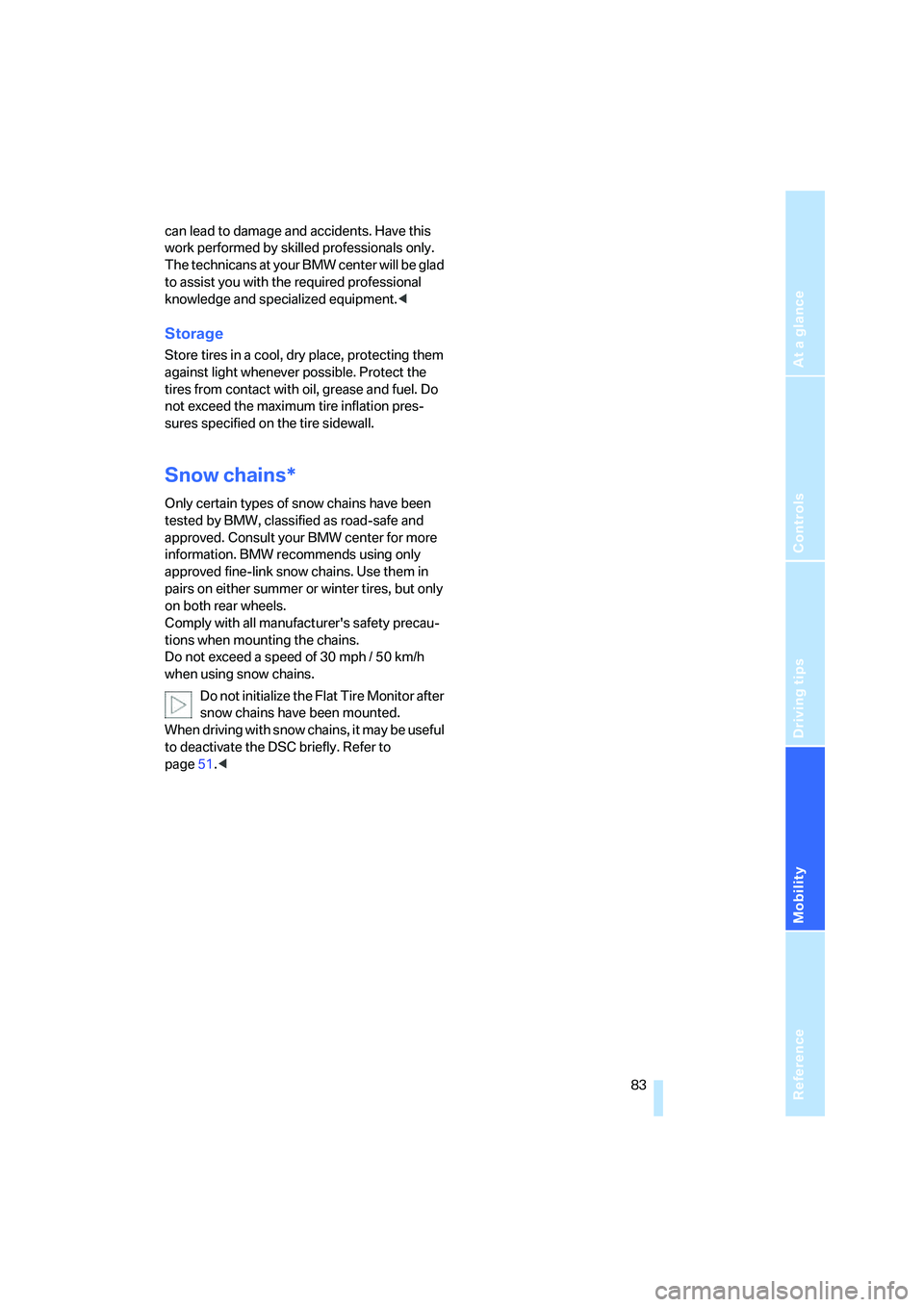
Reference
At a glance
Controls
Driving tips
Mobility
83
can lead to damage and accidents. Have this
work performed by skilled professionals only.
The technicans at your BMW center will be glad
to assist you with the required professional
knowledge and specialized equipment.<
Storage
Store tires in a cool, dry place, protecting them
against light whenever possible. Protect the
tires from contact with oil, grease and fuel. Do
not exceed the maximum tire inflation pres-
sures specified on the tire sidewall.
Snow chains*
Only certain types of snow chains have been
tested by BMW, classified as road-safe and
approved. Consult your BMW center for more
information. BMW recommends using only
approved fine-link snow chains. Use them in
pairs on either summer or winter tires, but only
on both rear wheels.
Comply with all manufacturer's safety precau-
tions when mounting the chains.
Do not exceed a speed of 30 mph / 50 km/h
when using snow chains.
Do not initialize the Flat Tire Monitor after
snow chains have been mounted.
When driving with snow chains, it may be useful
to deactivate the DSC briefly. Refer to
page51.<
Page 93 of 120
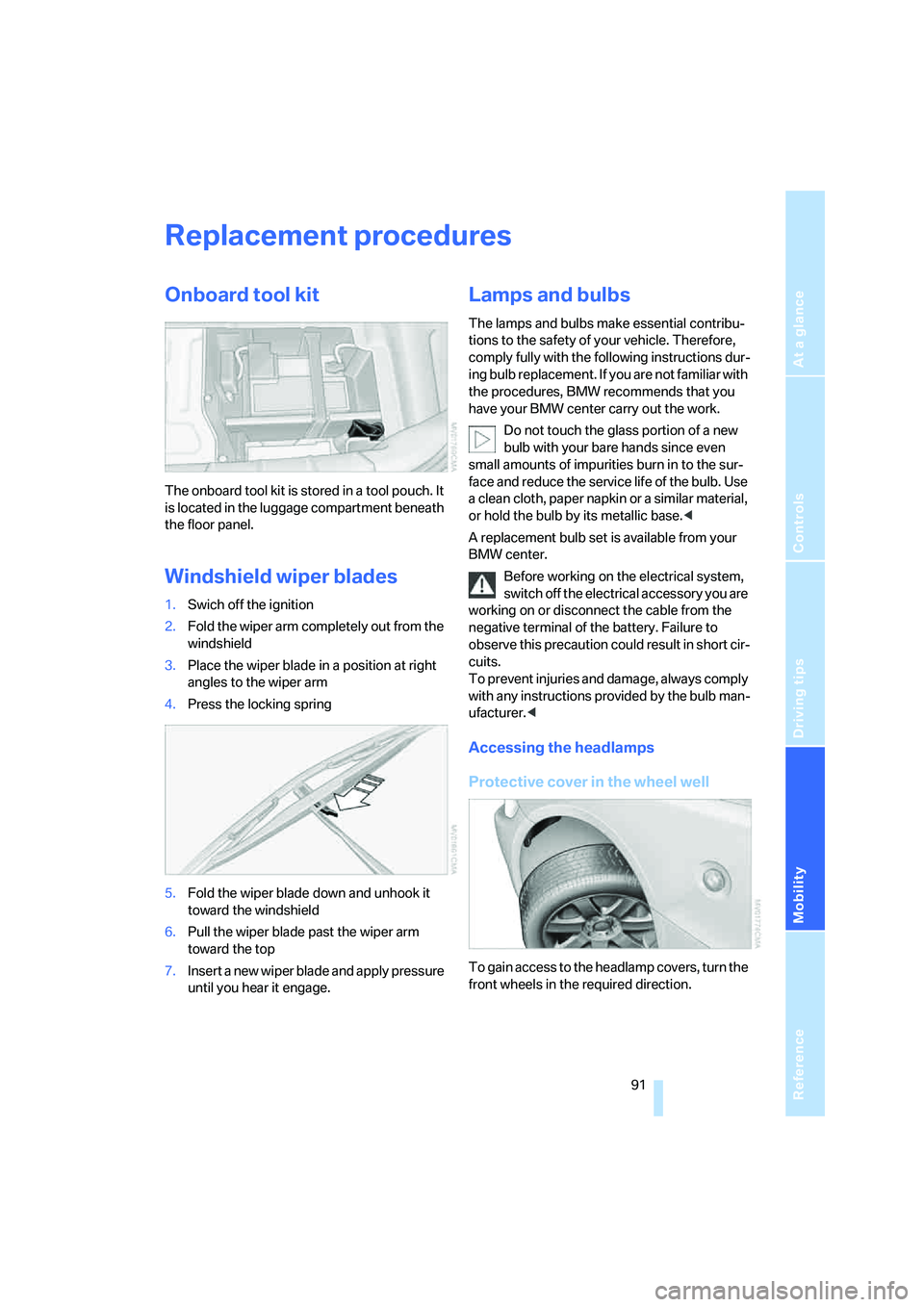
Reference
At a glance
Controls
Driving tips
Mobility
91
Replacement procedures
Onboard tool kit
The onboard tool kit is stored in a tool pouch. It
is located in the luggage compartment beneath
the floor panel.
Windshield wiper blades
1.Swich off the ignition
2.Fold the wiper arm completely out from the
windshield
3.Place the wiper blade in a position at right
angles to the wiper arm
4.Press the locking spring
5.Fold the wiper blade down and unhook it
toward the windshield
6.Pull the wiper blade past the wiper arm
toward the top
7.Insert a new wiper blade and apply pressure
until you hear it engage.
Lamps and bulbs
The lamps and bulbs make essential contribu-
tions to the safety of your vehicle. Therefore,
comply fully with the following instructions dur-
ing bulb replacement. If you are not familiar with
the procedures, BMW recommends that you
have your BMW center carry out the work.
Do not touch the glass portion of a new
bulb with your bare hands since even
small amounts of impurities burn in to the sur-
face and reduce the service life of the bulb. Use
a clean cloth, paper napkin or a similar material,
or hold the bulb by its metallic base.<
A replacement bulb set is available from your
BMW center.
Before working on the electrical system,
switch off the electrical accessory you are
working on or disconnect the cable from the
negative terminal of the battery. Failure to
observe this precaution could result in short cir-
cuits.
To prevent injuries and damage, always comply
with any instructions provided by the bulb man-
ufacturer.<
Accessing the headlamps
Protective cover in the wheel well
To gain access to the headlamp covers, turn the
front wheels in the required direction.
Page 94 of 120
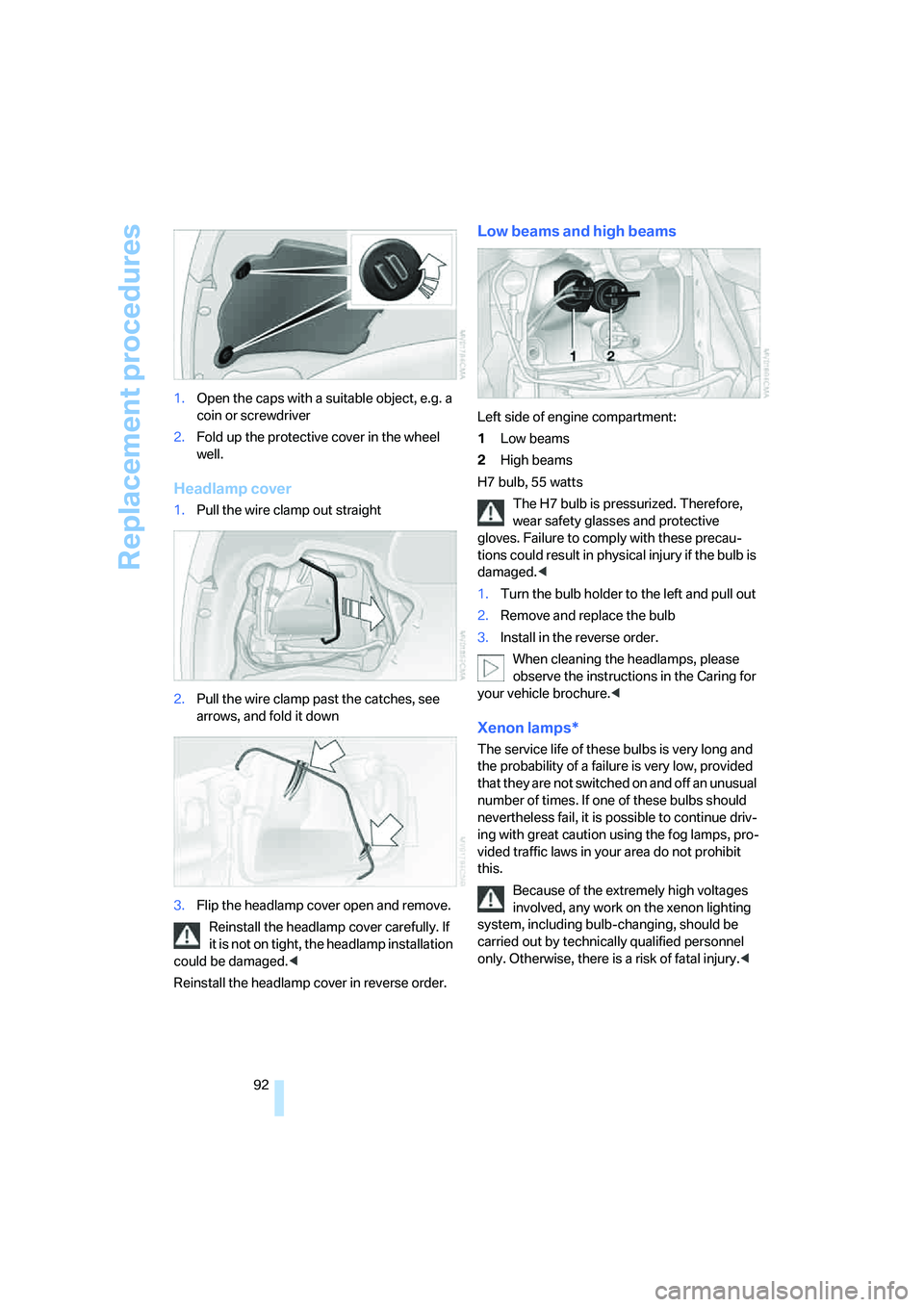
Replacement procedures
92 1.Open the caps with a suitable object, e.g. a
coin or screwdriver
2.Fold up the protective cover in the wheel
well.
Headlamp cover
1.Pull the wire clamp out straight
2.Pull the wire clamp past the catches, see
arrows, and fold it down
3.Flip the headlamp cover open and remove.
Reinstall the headlamp cover carefully. If
it is not on tight, the headlamp installation
could be damaged.<
Reinstall the headlamp cover in reverse order.
Low beams and high beams
Left side of engine compartment:
1Low beams
2High beams
H7 bulb, 55 watts
The H7 bulb is pressurized. Therefore,
wear safety glasses and protective
gloves. Failure to comply with these precau-
tions could result in physical injury if the bulb is
damaged.<
1.Turn the bulb holder to the left and pull out
2.Remove and replace the bulb
3.Install in the reverse order.
When cleaning the headlamps, please
observe the instructions in the Caring for
your vehicle brochure.<
Xenon lamps*
The service life of these bulbs is very long and
the probability of a failure is very low, provided
that they are not switched on and off an unusual
number of times. If one of these bulbs should
nevertheless fail, it is possible to continue driv-
ing with great caution using the fog lamps, pro-
vided traffic laws in your area do not prohibit
this.
Because of the extremely high voltages
involved, any work on the xenon lighting
system, including bulb-changing, should be
carried out by technically qualified personnel
only. Otherwise, there is a risk of fatal injury.<
Page 96 of 120
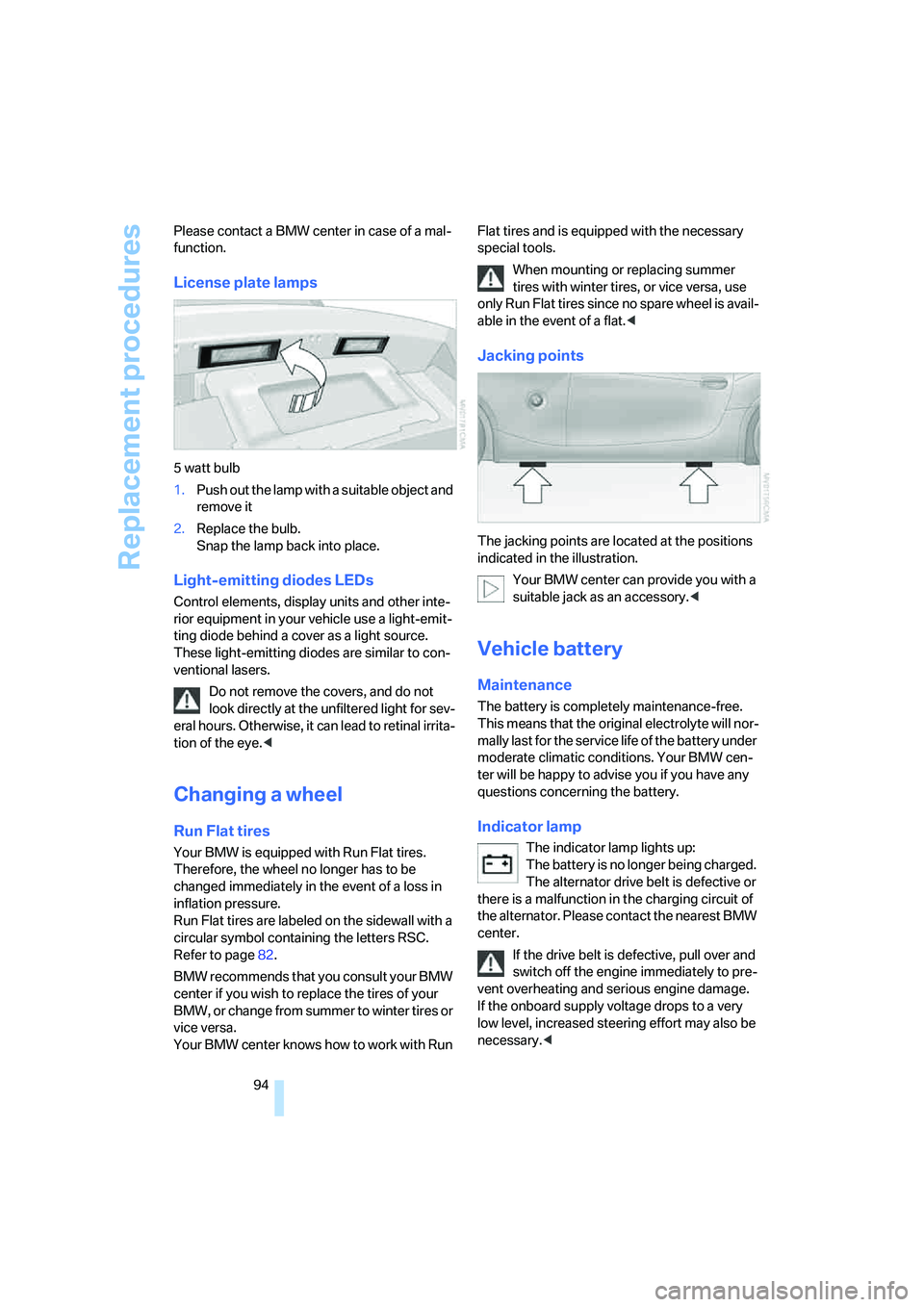
Replacement procedures
94 Please contact a BMW center in case of a mal-
function.
License plate lamps
5 watt bulb
1.Push out the lamp with a suitable object and
remove it
2.Replace the bulb.
Snap the lamp back into place.
Light-emitting diodes LEDs
Control elements, display units and other inte-
rior equipment in your vehicle use a light-emit-
ting diode behind a cover as a light source.
These light-emitting diodes are similar to con-
ventional lasers.
Do not remove the covers, and do not
look directly at the unfiltered light for sev-
eral hours. Otherwise, it can lead to retinal irrita-
tion of the eye.<
Changing a wheel
Run Flat tires
Your BMW is equipped with Run Flat tires.
Therefore, the wheel no longer has to be
changed immediately in the event of a loss in
inflation pressure.
Run Flat tires are labeled on the sidewall with a
circular symbol containing the letters RSC.
Refer to page82.
BMW recommends that you consult your BMW
center if you wish to replace the tires of your
B MW , o r change from summe r to winter tire s o r
vice versa.
Your BMW center knows how to work with Run Flat tires and is equipped with the necessary
special tools.
When mounting or replacing summer
tires with winter tires, or vice versa, use
only Run Flat tires since no spare wheel is avail-
able in the event of a flat.<
Jacking points
The jacking points are located at the positions
indicated in the illustration.
Your BMW center can provide you with a
suitable jack as an accessory.<
Vehicle battery
Maintenance
The battery is completely maintenance-free.
This means that the original electrolyte will nor-
mally last for the service life of the battery under
moderate climatic conditions. Your BMW cen-
ter will be happy to advise you if you have any
questions concerning the battery.
Indicator lamp
The indicator lamp lights up:
The battery is no longer being charged.
The alternator drive belt is defective or
there is a malfunction in the charging circuit of
the alternator. Please contact the nearest BMW
center.
If the drive belt is defective, pull over and
switch off the engine immediately to pre-
vent overheating and serious engine damage.
If the onboard supply voltage drops to a very
low level, increased steering effort may also be
necessary.<